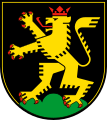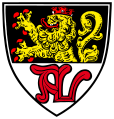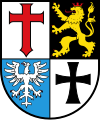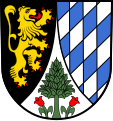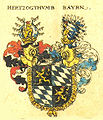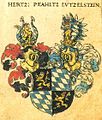Palatine Lion

The Palatine Lion (
Forms
The main design is described as sable a lion rampant or, crowned, armed and langued gules. Originally uncrowned, the lion was first depicted with a red crown in the early 14th century in the
In addition to these two main forms, there are a number of variants. Many villages used the symbols of their ruling families as seals. In order to minimise the risk of confusion, the detail of the coat of arms was changed when authority was granted to use them. Occasionally other colours were used in order to stay faithful to the rule of tincture.
-
The Palatine Lion of Neustadt an der Weinstraße as an example
-
Meckenheimuses the Electoral Palatine coat of arms with the addition of the letter "M".
-
Waldfischbach
-
Heltersberg, like Waldfischbach with the position of the paws altered
-
Rhein-Neckar-Kreis, altered tincture
-
Landkreis Neumarkt in der Oberpfalz
-
Worms-Ibersheim
-
Bammental, coat of arms with the lion and the diamonds of Electoral Palatinate
History
Emergence
The Palatine Lion first appears in the
Wittelsbach era
Following the enfeoffment of the Bavarian Duke
In
-
Palatinate-Lützelstein
Following the dissolution of the Palatine electorate in the wake of the
Post-war period

After the
In addition, the lion may be found in the state coats of arms of three other German
Representations of the Palatine Lion


Coats of arms
See: List of coats of arms with the Palatine Lion
Flags
The flag of the
Seal
In his book, Die Siegel der Deutschen Kaiser und Könige,[2] Otto Posse describes seals of the Electoral Palatine Imperial Vicariate:
- 1558: The count palatine in full armour on horseback with appropriate equipment (weapon, standard), in the background a princely palace, on the horse's blanket, 3 Imperial Orb for the archseneschal, the leftmost shield displays the Bavarian Wecken.
- 1612: On three escutcheons are: on the right hand one the Palatine Lion, in the centre the Imperial Orb and on the left hand one the Bavarian Wecken. On a helmet above is a crowned lion, on either side, the numbers 16 and 12 indicating the year.
Stonework
- The archway of the County of Veldenz.
- The Schriesheim coat of arms, granted to the village in 1896 based on a seal from 1381, is supported by the Palatine Lion. The detail was created out of Red Main sandstone in 1964 for an octagonal trough at the municipal fountain by a firm of stonemasons from the town on the occasion of the naming of the town.
- In front of the gate of the Frederick IIin their paws. This coat of arms also depicts the lion.
Paintings
The
See also
- Order of the Palatine Lion
- Veldenz lion
Literature
- Karl Heinz Debus: Das große Wappenbuch der Pfalz. Neustadt an der Weinstraße, 1988, ISBN 3-9801574-2-3
- Alfons Friderichs: Wappenbuch des Kreises Cochem-Zell, Darmstadt, 2001, ISBN 3-00-008064-3
- Herwig John, Gabriele Wüst: Wappenbuch Rhein-Neckar-Kreis. Ubstadt-Weiher, 1996, ISBN 3-929366-27-4
- Arnold Rabbow, Dieter Gube: Blätter zum Land 1′99: Landeswappen Rheinland-Pfalz (PDF; 562 kB). Mainz, 1999
References
- ^ a b Description of the state coat of arms of Rhineland-Palatinate (pdf; 562 kB)
- ^ Otto Posse: Die Siegel der Deutschen Kaiser und Könige, Vol. 5, pages 126 f. (Full text at Wikisource)






